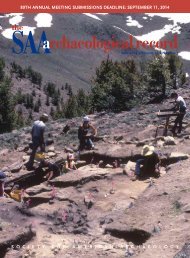SAA
Nov2016_web
Nov2016_web
You also want an ePaper? Increase the reach of your titles
YUMPU automatically turns print PDFs into web optimized ePapers that Google loves.
VIDEO GAMES AND ARCHAEOLOGY<br />
Microhistory, defined as “the intense historical investigation<br />
of a small area” (Szijártó 2002:209) studies a particular historical<br />
period with a high level of detail, many times centering<br />
the attention into a single person, place, or event. It<br />
concentrates on the personal experiences of everyday life,<br />
with the conviction that these small narratives provide a<br />
good standpoint to look into the broader sociocultural structures<br />
of past societies. Within the game, the player would<br />
assume the role of a particular Anglo-Saxon individual—a<br />
powerful ealdorman, ceorl, or even a slave—looking at the<br />
world through his eyes and experiencing his everyday life,<br />
problems, and limitations. As the camera moves further<br />
away from the character, the game allows the player to connect<br />
with a macrohistorical perspective. At this level, the<br />
emphasis is less on personal narratives and more on ideas of<br />
space, size, and distance in historical interpretation, allowing<br />
the player to explore the multiple relationships of interdependency<br />
between agents, resources, and game geography.<br />
The game offers multiple instances to make decisions,<br />
which reflect in long-term effects on the environment,<br />
resources, and larger social structures (Figure 1).<br />
Within the Anglo-Saxon game prototype, both instances of<br />
play are implemented through nested simulations, an<br />
approach that has been used in physical war games (Sabin<br />
2012) but to my knowledge not yet sufficiently explored in<br />
digital historical games. Digital implementations of this pattern<br />
consist of a series of relatively independent but interconnected<br />
simulations running historical processes at<br />
different scales. In more concrete terms, a first simulation<br />
runs an immersive, navigable third-person interface, which<br />
allows the player to walk around and interact with non-player<br />
agents and other objects from the environment. The player<br />
experience focuses on surviving the harsh life conditions of<br />
early medieval England, something that can only be achieved<br />
by establishing a successful, self-sustainable village. To do<br />
this, the player needs to interact with a second level of simulation,<br />
which drives the point of perception to the perspective<br />
of the entire game world. This system is modeled in more<br />
abstract terms through a hex grid, in which each hex represents<br />
a specific patch of land and contains detailed information<br />
about the village’s physical environment. Although<br />
separate, the interaction at both the immersive and village<br />
levels is necessary to achieve the game goals and any change<br />
in either the upper or lower simulation level have a substantial<br />
effect on the other (Figure 2).<br />
Although still not finished, the game prototype currently is<br />
at a state in which most of the systems responsible for interacting<br />
at different scales can be played. Looking ahead to the<br />
project’s plan, development will continue in iterative cycles<br />
of design, implementation, and evaluation. Through this<br />
process, my goal is to validate the gameplay ideas that allow<br />
users to interact and create meaningful links between with<br />
micro and macro perspectives, through the interplay<br />
between narrative and simulation systems and different levels<br />
of representation. Hopefully, the research project will<br />
yield design patterns and design principles that could be<br />
implemented in both historical and nonhistorical games,<br />
expanding to related domains of application, such as virtual<br />
reconstructions, museums, exhibitions, and formal learning<br />
contexts.<br />
References Cited<br />
Brewer, John<br />
2010 Microhistory and the Histories of Everyday Life. Cultural<br />
and Social History 7(1):87–109.<br />
Hartley, Leslie<br />
2002 [1953] The Go-Between. New York Review of Books, New<br />
York.<br />
King, Katie<br />
2008 Networked Reenactments: A Thick Description amid<br />
Authorships, Audiences and Agencies in the Nineties. Writing<br />
Technologies 2(1):1–8.<br />
Rosenzweig, Roy, and Thelen, David<br />
1998 The Presence of the Past: Popular Uses of History in American<br />
Life. Columbia University Press, New York.<br />
Sabin, Philip<br />
2012 Simulating War: Studying Conflict Through Simulation<br />
Games. Continuum International Publishing, London.<br />
Szijártó, István<br />
2002 Four Arguments for Microhistory. Rethinking History<br />
6(2):209–215.<br />
November 2016 • The <strong>SAA</strong> Archaeological Record<br />
37




